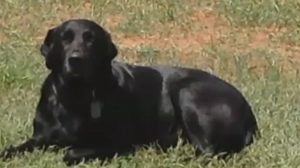
Blue.
By: Amy Slanchik
STILLWATER, Oklahoma – Oklahoma State University says its campus is the only place in the country providing ultrasound treatment services for dogs with cancer. One couple’s hope that the new technology will save their pet.
Mike and Judy Smith say they crossed paths with 10-year-old Blue back in 2010 and realized he didn’t have a home.
Now, vets are giving him what’s called a “focused ultrasound treatment” which uses sound waves to treat tumors. The technology is being used around the country but pet owners in Oklahoma have access to the service, right in their own backyard.
“OSU is unique in the sense that we are the only center that is offering focused ultrasound treatment as a service,” said OSU Associate Professor/Researcher Dr. Ashish Ranjan
The team at OSU plans to treat horses within the next few months, with the ultimate goal of improving the technology for people with cancer and other diseases. Dr. Ashish Ranjan helped bring the technology to OSU, after working for the National Institute of Health in Virginia.
“It’s pretty exciting. Its non-invasive, and you can do it pretty quickly,” said Dr. Ranjan.
He and Dr. Danielle Dugat are waiting on approval from the USDA to work on more complicated cases.
Right now, the Smiths are just thankful Blue qualifies for this treatment which vets say could extend his life.
For a video of this story, please follow this link.
(From American Veterinarian)
What Is Focused Ultrasound?
Relatively new, focused ultrasound is a noninvasive therapeutic technology that uses ultrasound energy guided by real-time imaging to kill tumors without surgery or radiation. Because it is noninvasive, focused ultrasound carries a reduced risk of infection, and the need for stitches and E-collars is eliminated. Focused ultrasound can also be used to ablate tissue or enhance the local delivery of therapeutic drugs. And because ionizing radiation is not involved, tumors can be treated in a single session—rather than the multiple visits requires for radiation therapy—and the treatments can be repeated.
“Traditionally, animals have served as models in comparative studies before expanding innovative therapies to human trials,” said Neal F. Kassell, MD, chairman for the Focused Ultrasound Foundation. “With this program, we are starting a virtuous cycle where veterinarians will have new, innovative therapies to offer clients, and we can apply the experience obtained using focused ultrasound in pets to accelerate the adoption of the technology for human applications.”








